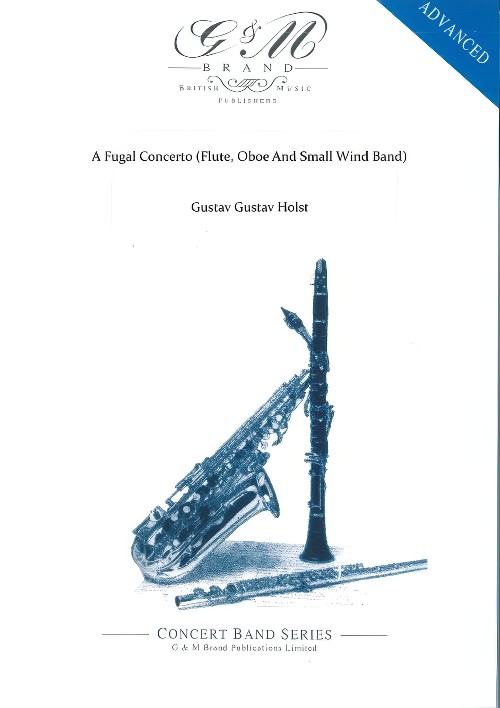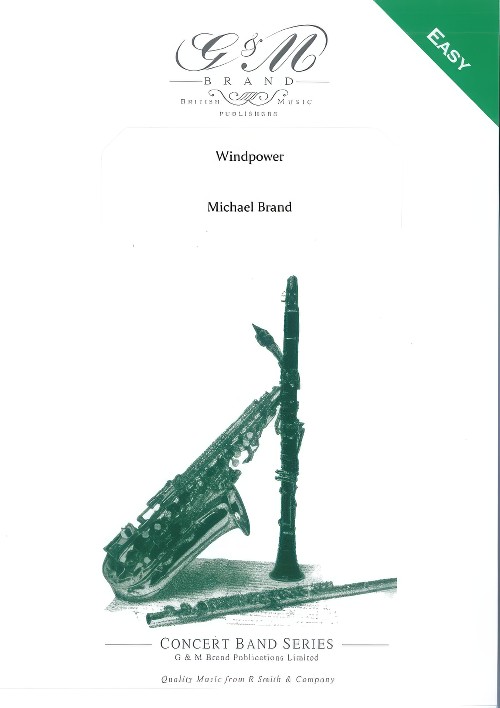Results
-
 £16.95
£16.95A Fugal Concerto (Flute, Oboe And Small Wind Band) (Concert Band - Score Only) - Holst, Gustav - Brand, Geoffrey
This work was originally written for flute, oboe (or two violins) and String Orchestra in 1923. This arrangement was premiered by the Stockholm Symphonic Winds in September 1993, conducted by the arranger. The style of A Fugal Concerto is very much neo-classical - all the rage at the time, although whether Holst had heard Stravinsky's examples is not known. In so far as the work is fugal, the adjective applies more to the texture than the form, although the second movement is canonic. The contrapuntal texture is not straightforward as phrases are displaced across barlines and cross rhythms are a feature. Nothing is allowed to settle until the folk tune is introduced toward the end. Yet, within this musical web, fascinating patterns and cross references reveal themselves.
Estimated dispatch 7-14 working days
-
 £59.95
£59.95Windpower (Concert Band - Score and Parts) - Brand, Michael
he piece evokes the relentless machine-like rhythm of a modern industrial engine powered by air. The machine minder lives next to this world every day, but during his work his mind drifts to more pleasant pursuits; a walk in the park, by the seaside, a summer's day? He live his inner life in a different sphere to his working day but the two can co-exist in harmony.
Estimated dispatch 7-14 working days
-
 £11.95
£11.95Windpower (Concert Band - Score Only) - Brand, Michael
he piece evokes the relentless machine-like rhythm of a modern industrial engine powered by air. The machine minder lives next to this world every day, but during his work his mind drifts to more pleasant pursuits; a walk in the park, by the seaside, a summer's day? He live his inner life in a different sphere to his working day but the two can co-exist in harmony.
Estimated dispatch 7-14 working days
-
 £84.99
£84.99Glasnost (Concert Band - Score and Parts) - Stratford, Dizzy
This composition by Dizzy Stratford symbolises the birth of the new Russia in the time of Mikhail Gorbachev with its new openness in public affairs (glasnost) accompanied by political and economic reform (perestroika). Glasnost is a work offering a modern vision of Russian music. Dizzy Stratford has chosen to combine the national hymn of the Soviet Union with two traditional melodies which, with a steady, energetic rhythm portray the wind of change and freedom in Russian society.Duration: 4:15
Estimated dispatch 7-14 working days
-
 £109.99
£109.99Arctic Funk Wind Band Set (Score & Parts)
Arctic Funk might just as well have been a flashing sequel to a scene from Leonard Bernstein's West Side Story. Popular music but with a difference, as indicated by the title. The work's quiet section temporarily soothes down the heated passion of its two corner movements, but everywhere else action is required throughout. The work was commissioned in 1991 by Troms? Brass. Situated just above the Polar Circle, Troms? is one of Norway's northernmost towns. Topographically, the town probably comes across as freezing cold, but Troms? is famous for its 'warm' night-life. The Composer: In Arctic Funk you might get a feeling of a party that takes place between ice-rocks and snow-capped mountains. 04:45
Estimated dispatch 7-14 working days
-
 £104.99
£104.99Augen in der Gro?'stadt Wind Band Set (Score & Parts)
Having already set to music two poems by Hermann Hesse (Stufen and Besinnung), Jacob de Haan has now made a musical arrangement of this famous poem by Kurt Tucholsky. It deals with life in the city, brief encounters, loneliness, people's yearnings and the all-consuming lack of time. Jacob de Haan's work can be performed either with a male or female voice, and the use of a microphone is recommended. 0:04:30
Estimated dispatch 7-14 working days
-
 £89.99
£89.99Band Fever (Concert Band - Score and Parts)
Modern wind music in the style of the great Big Bands was the model for the composition Band Fever by Otto M. Schwarz. It was written on commission of the prestigious South Tyrolese concert band, Symphonic Winds. The piece features two soloists, one saxophone and one flugel. Rhythms like Hip Hop Style and Double Samba support a catchy melody, which is later taken up by the full band, forming the basis for the above-mentioned soloists' improvisations. A unique work in the world of wind music, Band Fever allows both soloists and conductor to display individuality and creativity. It is especially suitable as an opener of the light part of a concert, or as a feature number for special soloists in the orchestra. 04:30
Estimated dispatch 7-14 working days
-
 £149.99
£149.99Concordia Wind Band Set (Score & Parts)
This unusual concert work, commissioned by the concert band ?Harmonie Concorde? from Sanem in Luxembourg, is built on two basic ideas: the evolution of the economic and social context of this Luxembourg city with its strong mining industry and the European concept, which is clearly present in this very small but prosperous country with its many European institutes. This is musically expressed in a few quotes from the European hymn Ode to Joy, the closing of Beethoven?s Ninth Symphony and from the Te Deum by Charpentier ? widely known as the signature tune for Eurovision broadcasts. A work of true unity. 0:10:00
Estimated dispatch 7-14 working days
-
 £204.99
£204.99Credentium Wind Band Set (Score & Parts)
A spectacular dive via an extended chromatic scale immediately submerges us in a charged and somewhat archaic-feeling atmosphere. Trumpets, horns and trombones resound in rhythmic patterns, buttressed by restless motifs in the percussion. A second theme, in the woodwinds, begins much calmer but is quickly pushed aside by that same brass offensive. This introduction is the musical expression of the sometimes tumultuous early history of the town of Peer in Belgium. It closes with a D scale played over two octaves and repeated three times, symbolizing the church steeples that dominate the townscape. Peer has the credentials of a town, and people should know about it.There follows a rhythmic, turbulent passage: in the course of history, Peer has not been spared the ravages of war, arson, occupation, epidemic and other evils. In contrast, a slow, pastoral, lyrical part expresses the periods of peace and prosperity the town has known, as well as the serene geographic setting that still characterizes the place. Various instruments in groups are developed in solo style while the accompaniment displays vast, painterly images of sound. Now and then an exotic intonation is heard: a variety of peoples and cultures have left their mark on the town.This episode of tranquility and peacefulness comes to a sudden end when, via a surprising, almost chaotic transitional passage, we are in effect transported back to our own time. A hopeful, festive march expresses the confidence in the future that the Royal Concert Band of Peer exudes. This confidence is wholly justified: under the direction of conductor Willy Fransen, the 95 members of the concert band have experienced an extended period of good fortune, and the 75 musicians of the youth band - and the 45 little musicians of the mini-band - are involved in thriving operations. 0:13:15
Estimated dispatch 7-14 working days
-
 £64.35
£64.35Double Concerto - Vivaldi, Antonio
This famous Allegro movement from a Vivaldi concerto for two trumpets is presented here in an arrangement loaded with flexibility as to choice of soloists and even the accompanying ensemble. May be performed as a solo or as a duet, and it includes solo/duet parts for Bb instruments: Trumpets or Clarinets; C Instruments: Flutes, Oboes, or Violins; Eb Instruments: Alto Saxophones; F Instruments: Horns; and Bass Clef instruments: Bassoons or Trombones. The accompaniment is cleverly scored so that it is playable by a full, traditional concert band; or by a "chamber wind ensemble" of woodwinds, horns, and timpani (ideal for accompanying upper woodwind soloists.) A great way to feature outstanding soloists from your band!
Estimated dispatch 7-14 working days
